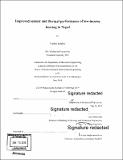Improved seismic and thermal performance of low-income housing in Nepal
Author(s)
Kuklov, Vadim.
Download1119389433-MIT.pdf (18.36Mb)
Other Contributors
Massachusetts Institute of Technology. Department of Mechanical Engineering.
Advisor
Leon Glicksman.
Terms of use
Metadata
Show full item recordAbstract
Many regions in the world are at risk for destructive seismic events and extreme weather patterns. A lack of resilient housing construction, combined with a loss of vernacular construction traditions, result in huge populations of low-income homeowners that cannot build homes that are safe and comfortable. Nepal exemplifies these risks, with frequent catastrophic earthquakes and a climate that is changing towards severe heat and cold weather events. The latest large earthquake in 2015 presents an opportunity to find innovative and sustainable ways to build homes that can effectively mitigate these risks. This work builds on the past work of the Building Technology group by applying a homeowner-driven design methodology to low income housing in Gorkha, Nepal. It investigates the needs and constraints of homeowners to find opportunity areas to improve the structural and thermal performance of their rebuilt homes. Using scaled testing and structural modeling this work finds promising ways to reinforce the mud mortar used in common stone and mud construction. Results indicate a 20-60% improvement in the predicted out of plane seismic resistance of a stone and mud wall when the mortar is reinforced with jute, goat hair, or coconut fibers. It also presents a case study in thermal comfort improvement using light roof insulation that uses thermal modeling and field experiments to verify its effectiveness, resulting in a 1.7°C improvement in the nighttime low and daytime high inside air temperature of a single room brick and tin roof home. These results are applicable to Nepal and many similar regions around the world. Using the results presented here as a foundation, future work can continue to iterate and develop implementation plans for these improvements, to be disseminated through existing partnerships and collaborations.
Description
Thesis: S.M., Massachusetts Institute of Technology, Department of Mechanical Engineering, 2019 Cataloged from PDF version of thesis. Includes bibliographical references (pages 81-84).
Date issued
2019Department
Massachusetts Institute of Technology. Department of Mechanical EngineeringPublisher
Massachusetts Institute of Technology
Keywords
Mechanical Engineering.